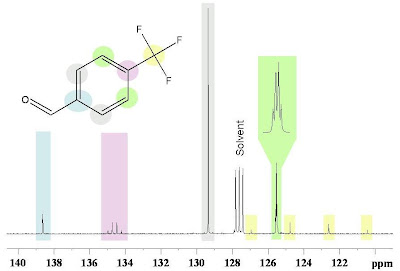Many NMR users (of the organic variety) come to believe that all 13C resonances are singlets as the most common way to collect the data is with proton decoupling, which indeed reduces most 13C resonances to singlets. It is a surprise to some to find multiplicity in the 13C resonances when a nucleus such as 31P or 19F is present in the molecule. Below is the aromatic region of the proton decoupled 13C NMR spectrum of alpha, alpha, alpha-trifluoro-p-tolualdehyde (the aldehyde peak is not shown). The assignments are given by the colors in the figure. Note the multiplicities in the 13C resonances due to the 1, 2 and 3 bond J coupling to 19F.

Some people find it surprising that the trifluorinated methyl group comes in the aromatic region of the spectrum. Fluorinated carbons are often difficult to find in 13C spectra with low signal-to-noise ratios as the signal is spread over multiple lines and can be buried in the noise.




